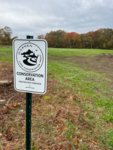- THURSDAY, MAY 2, 2024
Meadow makeover – great news for the birds and the bees
The project, which will take about four years to complete, has multiple ecological benefits, including flood resiliency and habitat restoration for the endangered saltmarsh sparrow.
This item is available in full to subscribers.
Please log in to continue |
Register to post eventsIf you'd like to post an event to our calendar, you can create a free account by clicking here. Note that free accounts do not have access to our subscriber-only content. |
Day pass subscribers
Are you a day pass subscriber who needs to log in? Click here to continue.
Meadow makeover – great news for the birds and the bees
A federally-funded project to restore the Sowams Meadows Preserve — a 26-acre wetland habitat along the Palmer River to the west of Market Street near its intersection with Schoolhouse Road — has begun, with workers mowing the expansive fields on the property, clearing invasive plants and preparing for the seeding of pollinating plants in the coming months.
The project, which will take about four years to complete, has multiple ecological benefits, according to Rock Singewald, president of the Warren Land Conservation Trust board of directors.
Once invasive species are cleared, the planting of various native and flowering trees and bushes in the fields, which were long used for farming hay, will provide an oasis for bees, which act as crucial pollinators for flowers and crops.
Simultaneously, Save the Bay will assist by creating trenches called runnels within the salt marsh area of the property to restore a more healthy flow of salt and freshwater between the wetlands and the area further inland. That would have multiple benefits, including the repression of invasive phragmites and the promotion of habitat growth for the endangered saltmarsh sparrow.
“All of the marshes up and down the Palmer are habitat for the sparrows,” Singewald said. “Increasing saltwater flow and making saltmarsh grasses grow will create better habitat for the sparrows.”
A healthier marsh will also help with continuing to bolster Warren’s resiliency to increased incidents of flooding as a result of climate change and sea level rise.
“A healthy marsh will absorb more flood waters than a depleted marsh. This is all part of a longer-term look at resiliency and providing ways to prevent flooding along the coast of the river,” Singewald said. “Sea levels are going to rise, but this is a better way to deal with it. Marshes are important from an ecological standpoint — they’re a great breeding ground for fish and birds — but they’re also sponges. They really are natural defenses to coastal flooding. The more marshes we have the better off we are.”
Singewald said that, once the project is complete, there are plans to implement a public walkway through the various flowering plants and into the wetlands, as has been done at various properties the land trust protects.
More about the project
The project is being fully funded through the Natural Resource Conservation Service, an agency within the United States Department of Agriculture (USDA). Save the Bay will work in partnership with NRCS. Adding some local interest, the contractor chosen by the federal government to complete the work was Warren’s own Staton’s Landscaping, owned by Chuck Staton, chairman of the town’s tree commission. Dave Frerichs, of Frerichs Farm, was also subcontracted to mow the property.
Sowams Meadows Preserve was gifted to the Warren Land Conservation Trust in 2020 by Karen Burnes. Further to the north, the trust has its largest property, the 61-acre Haile Farm Preserve, and to the south is another 11.5 acres of protected land at Belcher’s Cove. Singewald was appreciative for the community partnerships and easements that have been secured to enable those properties to remain protected.
“It’s a pretty good sweep we now have along the Palmer River,” Singewald said. “We’re really excited and looking forward to the future.”
The known history of Sowams Meadow goes all the way back to the first activities of European settlers in the area, when English Pilgrims interacted with the Massasoit Ousamequin (Yellow Feather) of the Pokanoket Nation in 1621. The native peoples prized the Sowams area for its rich soil and abundance of natural resources.
Other items that may interest you







